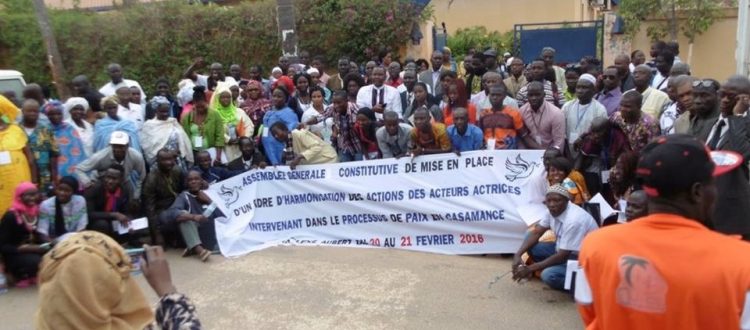Senegal’s southern conflict – forgotten but not gone
The conflict in Senegal rumbles on, unnoticed by most of the world and apparently unimportant to the Senegalese government. But citizens in Casamance continue to suffer. In response, locals are trying to forge their own peace process to end a forty-year war.
| Suggested Reading | Conflict Background | GCCT |
By Tomas Serna
According to legend, Galileo, after being forced by the Inquisition to renounce his claim that the earth moved around the sun, he said “E pur si muove” – “and yet it moves.” His theory was verified later.
While not reaching the violence of other African conflicts Casamance is still in a setting of non-peace. In spite of a common willing to ignore it, the conflict still moves. Unfortunately, the peace process isn’t moving – in fact, the peace process doesn’t really exist.
The conflict is bad for Senegal’s reputation and regional relations, and the war economy of cashew nuts and cannabis has “undermined any urgency to end the conflict.”
Non-peace can be seen in the mistrust and distance between “hommes de tenue”, that is, the military, the gendarmerie, other representatives of the state, and common citizens. Non-peace can be seen in the sometimes disturbing military presence. Non-peace can be seen in the mines that are still in evidence around the country; the November meeting of the international mine ban convention concluded that “the stagnation of survey and clearance operations in recent years, and Senegal’s apparent reluctance to deploy clearance assets in Confirmed Mine Areas, such as around military installations, are worrying signs. They suggest that Senegal still lacks a comprehensive understanding of its mine problem as well as a realistic strategy to comply with its Article 5 obligations [to clear all anti-personnel mines in mined areas under its jurisdiction within ten years].”
Finally, non-peace can be seen in the perpetuation of red zones. Vast areas of the departments of Bignona, Oussouye, Goudomp and Ziguinchor are still not under the full control of the state. Cut off from the rest of Senegal, neither civil servants nor development operators dare to go there. How many abandoned citizens are there? Nobody really knows.
The Achiles heel of stable and democratic Senegal is probably the inexistence of a peace process as such. The “historical resistance” to direct engagement in mediation explains the fact that the current two principal mediators in the Casamance ‘peace process’, Sant’Egidio and the Center for Humanitarian Dialogue, are non-state actors.
Non-state actors are, however, present in the international arena. They are called upon to propose conflict resolution and mediation services when state actors are unwilling or unable to do so. Their relative independence and impartiality, and their supposed professionalism and experience, can help fill gaps.
St Egidio is an ecumenical community headquartered in Rome who have provided strong contributions for peace in Mozambique. Through a conscious decision St. Egidio was designated to mediate by the Senegalese government. But after four years its outcomes are neither transparent nor tangible.
The Centre for Humanitarian Dialogue (HD) is a Swiss-based private diplomacy organisation which boasts about being one of the world’s leading organisations in the field of conflict mediation. HD was invited by the government to mediate with the southern wing of the maquis. But in three years the staff haven’t been able even to meet the maquis leader.
Given the failure of champion mediators, the breakdown of action on mines, and the apparent veto on regional and international involvement, the Senegalese government seems to be lost again. The voices of Casamancais citizens, who will be directly affected by any agreement, should be heard and incorporated into any process. Their relative silence is a main indicator of the non-peace setting. But local peace builders are ready to take up the challenge.
Despite its diversity, its different focus and opinions, and despite the fact that there is fierce competition between them in the development “market”, civil society peace builders largely agree on the failure of the state to deal with the conflict in Casamance, and the failure of non-state mediation engaged by the state. Given this failure they are willing to explore what they are able to offer for peace.
Like the earth around the sun, local civil society moves in Casamance. Their current efforts to establish a federative network of local peace builders and join forces for peace should be blessed, with an initiative led by the Coordination des Organisations de la Société Civile pour la paix en Casamance , or COSCPAC (Coordiation of civility society organisations for peace in Casamance). This is the result of a long process of meetings and discussions between civil society organisations of the three Casamance regions: Kolda, Sedhiou and Ziguinchor, joined by organisations from Guinea Bissau and The Gambia.
Its General Assembly was held in Ziguinchor in March 2016, and unlike many other instances the legitimacy of this sub-regional federative network of local peace builders is based on its solid anchor in society and its citizens. Henry Ndecky, who is the elected president of the board, stresses that the COSCPAC’s objective is to promote social dialogue, to go beyond the ‘no war, no peace’ stage, and to bring the state of Senegal and the Movement of Democratic Forces of Casamance to the signature of a permanent cessation of hostilities.
This year, COSCPAC will be organising activities in Zuiguinchor for International Peace Day on September 21. Let us hope that peace will come.
Tomas Serna is Insight on Conflict’s Local Peacebuilding Expert in Guinea-Bissau and Senegal.
This article was originally published by Insight on Conflict and is available by clicking here. The views presented in this piece do not necessarily reflect those of TransConflict.




















RT @TransConflict: #Senegal’s southern #conflict – forgotten but not gone: The conflict in Senegal rumbles on… https://t.co/qHjCTi7PCW
RT @gcct_tc: #Senegal’s southern #conflict – forgotten but not gone: The conflict in Senegal rumbles on… https://t.co/7aeuqfVOzR